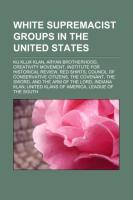White Supremacist Groups in the United States
BücherAngebote / Angebote:
Source: Wikipedia. Pages: 62. Chapters: Ku Klux Klan, Aryan Brotherhood, Creativity Movement, Institute for Historical Review, Red Shirts, Council of Conservative Citizens, The Covenant, The Sword, and the Arm of the Lord, Indiana Klan, United Klans of America, League of the South, National Alliance, German American Bund, Liberty Lobby, American Nazi Party, Volksfront, White power skinhead, New Order, White Citizens' Council, American Front, The Order, Posse Comitatus, National Vanguard, White Aryan Resistance, White Knights of the Ku Klux Klan, Women of the Ku Klux Klan, National States' Rights Party, White League, Imperial Klans of America, Nazi Lowriders, Hammerskins, Nationalist Movement, White Order of Thule, National Socialist League, European Kindred, New Century Foundation, Redneck Shop, Silver Legion of America, Aryan Republican Army, White Patriot Party, National Socialist Movement, Phineas Priesthood, National Renaissance Party, National Socialist Party of America, Church of Jesus Christ-Christian, National Association for the Advancement of White People, Black Legion, National Youth Alliance, European-American Unity and Rights Organization, Workingman's Party, Knights of the White Camelia, Assembly of Christian Soldiers, Friends of New Germany, White Citizens Parties, Free Society of Teutonia, Kingdom Identity Ministries, All-American Protectorate, Inc., Counter-Revolutionary Organization on Salvation and Service, Supreme Order of Caucasians. Excerpt: Ku Klux Klan, often abbreviated KKK and informally known as The Klan, is the name of three distinct past and present far-right organizations in the United States, which have advocated extremist reactionary currents such as white supremacy, white nationalism, and anti-immigration, historically expressed through terrorism. Since the mid-20th century, the KKK has also been anti-communist. The current manifestation is splintered into several chapters and is classified as a hate group. The first Klan flourished in the South in the 1860s, then died out by the early 1870s. Members adopted white costumes: robes, masks, and conical hats, designed to be outlandish and terrifying, and to hide their identities. The second KKK flourished nationwide in the early and mid 1920s, and adopted the same costumes and code words as the first Klan, while introducing cross burnings. The third KKK emerged after World War II and was associated with opposing the civil rights movement and progress among minorities. The second and third incarnations of the Ku Klux Klan made frequent reference to America's "Anglo-Saxon" and "Celtic" blood, harking back to 19th-century nativism and claiming descent from the original 18th-century British colonial revolutionaries. All incarnations of the Klan have well-established records of engaging in terrorism, though historians debate how widely the tactic was supported by the membership of the second KKK. The first Klan was founded in 1865 in Pulaski, Tennessee, as a terrorist organization by veterans of the Confederate Army. They named it after the Greek word 'kuklos", which means circle. The name means "Circle of Brothers." Although there was no organizational structure above the local level, similar groups arose across the South, adopting the name and methods. Klan groups spread throughout the South as an insurgent movement during the Reconstruction era in the United States. As a secret vigilante group, the Klan targeted freedmen and their allies, it s...
Folgt in ca. 10 Arbeitstagen

